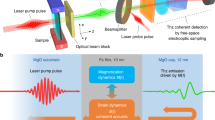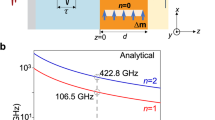Abstract
Spin-dependent conduction in metals underlies all modern magnetic memory technologies, such as giant magnetoresistance (GMR). The charge current in ferromagnetic transition metals is carried by two non-mixing populations of sp-band Fermi-level electrons: one of majority-spin and one of minority-spin. These electrons experience spin-dependent momentum scattering with localized electrons, which originate from the spin-split d-band. The direct observation of magnetotransport under such fundamental conditions, however, requires magnetotransport measurements on the same timescale as the electron momentum scattering, which takes place in the sub-100 fs regime. Using terahertz electromagnetic probes, we directly observe the magnetotransport in a metallic system under the fundamental conditions, and determine the spin-dependent densities and momentum scattering times of conduction electrons. We show that traditional measurements significantly underestimate the spin asymmetry in electron scattering, a key parameter responsible for effects such as GMR. Furthermore, we demonstrate the possibility of magnetic modulation of terahertz waves, along with heat- and contact-free GMR readout using ultrafast terahertz signals.
This is a preview of subscription content, access via your institution
Access options
Subscribe to this journal
Receive 12 print issues and online access
$209.00 per year
only $17.42 per issue
Buy this article
- Purchase on Springer Link
- Instant access to full article PDF
Prices may be subject to local taxes which are calculated during checkout



Similar content being viewed by others
References
McFadyen, I. R., Fullerton, E. E. & Carey, M. J. State-of-the-art magnetic hard disk drives. MRS Bull. 31, 379–383 (2006).
Baibich, M. N. et al. Giant magnetoresistance of (001)Fe/(001)Cr magnetic superlattices. Phys. Rev. Lett. 61, 2472–2475 (1988).
Grünberg, P., Schreiber, R., Pang, Y., Brodsky, M. B. & Sowers, H. Layered magnetic structures: Evidence for antiferromagnetic coupling of Fe layers across Cr interlayers. Phys. Rev. Lett. 57, 2442–2445 (1986).
Binasch, G., Grünberg, P., Saurenbach, F. & Zinn, W. Enhanced magnetoresistance in layered magnetic structures with antiferromagnetic interlayer exchange. Phys. Rev. B 39, 4828–4830 (1989).
Hirota, E., Sakakima, H. & Inomata, K. Giant Magneto-Resistance Devices (Springer, 2002).
Stöhr, J. & Siegmann, H. C. Magnetism: From Fundamentals to Nanoscale Dynamics (Springer, 2006).
Mott, N. F. The electrical conductivity of transition metals. Proc. R. Soc. Lond. A 153, 699–717 (1936).
Motzko, N. et al. Spin relaxation in Cu and Al spin conduits. Phys. Status Solidi A 211, 986–990 (2014).
Villamor, E., Isasa, M., Hueso, L. & Casanova, F. Contribution of defects to the spin relaxation in copper nanowires. Phys. Rev. B 87, 094417 (2013).
Jedema, F. J., Filip, A. T. & van Wees, B. J. Electrical spin injection and accumulation at room temperature in an all-metal mesoscopic spin valve. Nature 410, 345–348 (2001).
Laman, N. & Grischkowsky, D. Terahertz conductivity of thin metal films. Appl. Phys. Lett. 93, 051105 (2008).
Melnikov, A. et al. Ultrafast transport of laser-excited spin-polarized carriers in Au/Fe/MgO(001). Phys. Rev. Lett. 107, 076601 (2011).
Aeschlimann, M. et al. Ultrafast spin-dependent electron dynamics in fcc Co. Phys. Rev. Lett. 79, 5158–5161 (1997).
Lisowski, M. et al. Femtosecond electron and spin dynamics in Gd(0001) studied by time-resolved photoemission and magneto-optics. Phys. Rev. Lett. 95, 137402 (2005).
Goris, A. et al. Role of spin-flip exchange scattering for hot-electron lifetimes in cobalt. Phys. Rev. Lett. 107, 026601 (2011).
Valet, T. & Fert, A. Theory of the perpendicular magnetoresistance in magnetic multilayers. Phys. Rev. B 48, 7099–7113 (1993).
Zarate, E., Apell, P. & Echenique, P. M. Calculation of low-energy-electron lifetimes. Phys. Rev. B 60, 2326–2332 (1999).
Hong, J. & Mills, D. L. Spin dependence of the inelastic electron mean free path in Fe and Ni: Explicit calculations and implications. Phys. Rev. B 62, 5589–5600 (2000).
Zhukov, V. P., Chulkov, E. V. & Echenique, P. M. Lifetimes and inelastic mean free path of low-energy excited electrons in Fe, Ni, Pt, and Au: Ab initio GW+T calculations. Phys. Rev. B 73, 125105 (2006).
Zhukov, V. P., Chulkov, E. V. & Echenique, P. M. Lifetimes of excited electrons in Fe and Ni: First-principles GW and the T-matrix theory. Phys. Rev. Lett. 93, 096401 (2004).
Beaurepaire, E., Merle, J., Daunois, A. & Bigot, J. Ultrafast spin dynamics in ferromagnetic nickel. Phys. Rev. Lett. 76, 4250–4253 (1996).
Beaurepaire, E. et al. Coherent terahertz emission from ferromagnetic films excited by femtosecond laser pulses. Appl. Phys. Lett. 84, 3465–3467 (2004).
Kirilyuk, A., Kimel, A. V. & Rasing, T. Ultrafast optical manipulation of magnetic order. Rev. Mod. Phys. 82, 2731–2784 (2010).
Walowski, J. et al. Energy equilibration processes of electrons, magnons, and phonons at the femtosecond time scale. Phys. Rev. Lett. 101, 237401 (2008).
Malinowski, G. et al. Control of speed and efficiency of ultrafast demagnetization by direct transfer of spin angular momentum. Nature Phys. 4, 855–858 (2008).
Kampfrath, T. et al. Terahertz spin current pulses controlled by magnetic heterostructures. Nature Nanotechnol. 8, 256–260 (2013).
Pfau, B. et al. Ultrafast optical demagnetization manipulates nanoscale spin structure in domain walls. Nature Commun. 3, 1100 (2012).
Eschenlohr, A. et al. Ultrafast spin transport as key to femtosecond demagnetization. Nature Mater. 12, 332–336 (2013).
Tonouchi, M. Cutting-edge terahertz technology. Nature Photon. 1, 97–105 (2007).
Ulbricht, R., Hendry, E., Shan, J., Heinz, T. F. & Bonn, M. Carrier dynamics in semiconductors studied with time-resolved terahertz spectroscopy. Rev. Mod. Phys. 83, 543–586 (2011).
Scheffler, M., Dressel, M., Jourdan, M. & Adrian, H. Extremely slow Drude relaxation of correlated electrons. Nature 438, 1135–1137 (2005).
Mics, Z., D’Angio, A., Jensen, S. A., Bonn, M. & Turchinovich, D. Density-dependent electron scattering in photoexcited GaAs in strongly diffusive regime. Appl. Phys. Lett. 102, 231120 (2013).
Kampfrath, T. et al. Coherent terahertz control of antiferromagnetic spin waves. Nature Photon. 5, 31–34 (2011).
Jin, Z. et al. Single-pulse terahertz coherent control of spin resonance in the canted antiferromagnet YFeO3, mediated by dielectric anisotropy. Phys. Rev. B 87, 094422 (2013).
Kubacka, T. et al. Large-amplitude spin dynamics driven by a THz pulse in resonance with an electromagnon. Science 343, 1333–1336 (2014).
Parkin, S. S. P. & Mauri, D. Spin engineering: Direct determination of the Ruderman–Kittel–Kasuya–Yosida far-field range function in ruthenium. Phys. Rev. B 44, 7131–7134 (1991).
Hartmann, U. (ed.) Magnetic Multilayers and Giant Magnetoresistance: Fundamentals and Industrial Applications (Springer, 2000).
Zahn, P., Binder, J., Mertig, I., Zeller, R. & Dederichs, P. H. Origin of giant magnetoresistance: Bulk or interface scattering. Phys. Rev. Lett. 80, 4309–4312 (1998).
Dieny, B. et al. Giant magnetoresistance of magnetically soft sandwiches: Dependence on temperature and on layer thickness. Phys. Rev. B 45, 806–813 (1992).
Weiss, R., Mattheis, R. & Reiss, G. Advanced giant magnetoresistance technology for measurement applications. Meas. Sci. Technol. 24, 082001 (2013).
Hoffmann, M. C. & Turchinovich, D. Semiconductor saturable absorbers for ultrafast terahertz signals. Appl. Phys. Lett. 96, 151110 (2010).
Turchinovich, D., Hvam, J. M. & Hoffmann, M. C. Self-phase modulation of a single-cycle terahertz pulse by nonlinear free-carrier response in a semiconductor. Phys. Rev. B 85, 201304(R) (2012).
Kampfrath, T., Tanaka, K. & Nelson, K. A. Resonant and nonresonant control over matter and light by intense terahertz transients. Nature Photon. 7, 680–690 (2013).
Walther, M. et al. Terahertz conductivity of thin gold films at the metal-insulator percolation transition. Phys. Rev. B 76, 125408 (2007).
Smith, N. V. Classical generalization of the Drude formula for the optical conductivity. Phys. Rev. B 64, 155106 (2001).
Nemec, H. et al. Charge transport in TiO films with complex percolation pathways investigated by time-resolved terahertz spectroscopy. IEEE Trans. THz Sci. Technol. 3, 302–313 (2013).
Tsymbal, E. Y. & Pettifor, D. G. Perspectives of giant magnetoresistance. Solid State Phys. 56, 113–237 (2001).
Ignatenko, S. A. Effect of interfacial s-d scattering on transport in structures ferromagnet/insulator/ferromagnet. Tech. Phys. 51, 1398–1404 (2006).
Langlinais, J. & Callaway, J. Energy bands in ferromagnetic nickel. Phys. Rev. B 5, 124–134 (1972).
Tawil, R. A. & Callaway, J. Energy bands in ferromagnetic iron. Phys. Rev. B 7, 4242–4252 (1973).
Soulen, R. J. Jr et al. Measuring the spin polarization of a metal with a superconducting point contact. Science 282, 85–88 (1998).
Zhang, X.-G. & Butler, W. H. Band structure, evanescent states, and transport in spin tunnel junctions. J. Phys. Condens. Matter 15, R1603–R1639 (2003).
Žutić, I., Fabian, J. & Sarma, S. Spintronics: Fundamentals and applications. Rev. Mod. Phys. 76, 323–410 (2004).
Acknowledgements
We are grateful to A. Fert, G. Güntherodt and M. Jourdan for their comments on this work, and to Z. Mics, I. Ivanov and F. D’Angelo for helpful discussions and assistance. We acknowledge financial support by EU Career Integration Grant 334324 LIGHTER, Max Planck Society, Graduate School of Excellence Materials Science in Mainz (MAINZ) GSC 266, the EU (MASPIC, ERC-2007-StG 208162; WALL, FP7-PEOPLE-2013-ITN 608031), the DFG, Research Center of Innovative and Emerging Materials CINEMA, and the EFRE Project 81037755 ‘STeP’ (Spintronic Technology Platform Rhineland-Palatinate).
Author information
Authors and Affiliations
Contributions
D.T. and M.K. conceived the project. Z.J. and D.T. performed the terahertz experiments, and A.Tkach and M.K. performed the static characterization. F.C., V.S. and H.G. produced the samples. Z.J. and D.T. analysed the terahertz data, with the help of M.B., T.K. and A.Thomas. D.T. wrote the paper with contributions from Z.J., M.K., T.K., A.Thomas and M.B. All authors discussed the results and commented on the manuscript.
Corresponding author
Ethics declarations
Competing interests
The authors declare no competing financial interests.
Supplementary information
Supplementary Information
Supplementary Information (PDF 530 kb)
Rights and permissions
About this article
Cite this article
Jin, Z., Tkach, A., Casper, F. et al. Accessing the fundamentals of magnetotransport in metals with terahertz probes. Nature Phys 11, 761–766 (2015). https://doi.org/10.1038/nphys3384
Received:
Accepted:
Published:
Issue Date:
DOI: https://doi.org/10.1038/nphys3384
This article is cited by
-
Temperature dependence of intrinsic and extrinsic contributions to anisotropic magnetoresistance
Scientific Reports (2021)
-
Ultrafast terahertz magnetometry
Nature Communications (2020)
-
Universal field-tunable terahertz emission by ultrafast photoinduced demagnetization in Fe, Ni, and Co ferromagnetic films
Scientific Reports (2020)
-
Up to 70 THz bandwidth from an implanted Ge photoconductive antenna excited by a femtosecond Er:fibre laser
Light: Science & Applications (2020)
-
A terahertz in-line polarization converter based on through-via connected double layer slot structures
Scientific Reports (2017)



